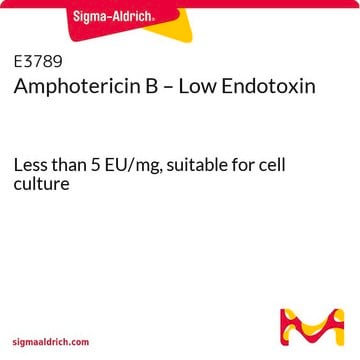F3174
Fpg Protein from Escherichia coli
≥90% (SDS-PAGE), buffered aqueous glycerol solution, >20,000 units/mg protein, suitable for genomic analysis
Sinonimo/i:
DNA-(apurinic or apyrimidinic site)lyase MutM (APlyase MutM), Fapy-DNAglycosylase, Formamidopyrimidine-DNA glycosylase, Fpg Protein from Escherichia coli, Recombinant, Fapy DNA glycosylase, Formamidopyrimidine DNA glycosylase, MutM
About This Item
Prodotti consigliati
Origine biologica
Escherichia coli
Livello qualitativo
Ricombinante
expressed in E. coli
Saggio
≥90% (SDS-PAGE)
Forma fisica
buffered aqueous glycerol solution
Attività specifica
>20,000 units/mg protein
PM
30.2 kDa (269 amino acids, predicted from the nucleotide sequence)
Composizione
protein, 0.1- 0.3 mg/mL Bradford
Condizioni di stoccaggio
(Tightly closed)
tecniche
nucleic acid detection: suitable
N° accesso UniProt
applicazioni
genomic analysis
Condizioni di spedizione
wet ice
Temperatura di conservazione
−20°C
Informazioni sul gene
Escherichia coli CFT073 ... mutM(1038243)
Escherichia coli K12 ... mutM(946765)
Descrizione generale
Research area: Cell signaling
Applicazioni
Azioni biochim/fisiol
Definizione di unità
Stato fisico
Codice della classe di stoccaggio
10 - Combustible liquids
Classe di pericolosità dell'acqua (WGK)
WGK 2
Punto d’infiammabilità (°F)
Not applicable
Punto d’infiammabilità (°C)
Not applicable
Dispositivi di protezione individuale
Eyeshields, Gloves, multi-purpose combination respirator cartridge (US)
Certificati d'analisi (COA)
Cerca il Certificati d'analisi (COA) digitando il numero di lotto/batch corrispondente. I numeri di lotto o di batch sono stampati sull'etichetta dei prodotti dopo la parola ‘Lotto’ o ‘Batch’.
Possiedi già questo prodotto?
I documenti relativi ai prodotti acquistati recentemente sono disponibili nell’Archivio dei documenti.
Il team dei nostri ricercatori vanta grande esperienza in tutte le aree della ricerca quali Life Science, scienza dei materiali, sintesi chimica, cromatografia, discipline analitiche, ecc..
Contatta l'Assistenza Tecnica.






